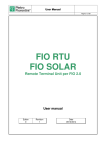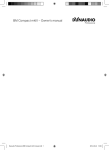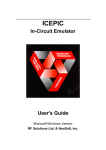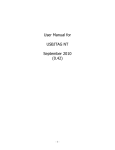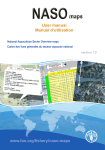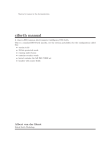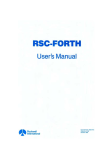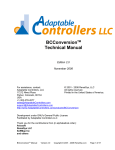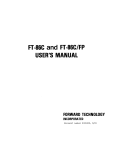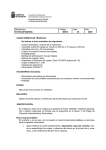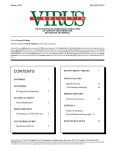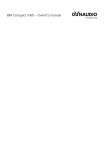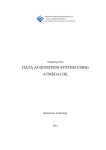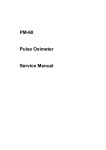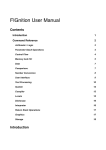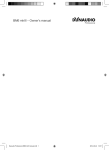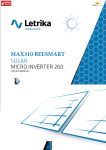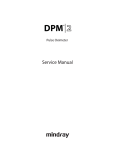Download FORTHdsPIC User Manual
Transcript
FORTHdsPIC User Manual Contents FORTHdsPIC User Manual ......................................................................................................................... 1 1. 2. Introduction ................................................................................................................................... 2 System Requirements .................................................................................................................... 2 2.1. MicroStick II Development Board ........................................................................................... 2 2.2. Custom Development Board .................................................................................................. 2 3. Installing FORTHdsPIC .................................................................................................................... 3 3.1. MicroStick II Development Board ........................................................................................... 3 3.2. Custom Development Board .................................................................................................. 3 4. Running FORTHdsPIC ..................................................................................................................... 4 4.1. MicroStick II Development Board ........................................................................................... 4 4.2. Custom Development Board .................................................................................................. 4 5. Running FORTH in Interpreter Mode ............................................................................................. 5 5.1. Simple Command Line ............................................................................................................ 5 6. Running FORTH Programs .............................................................................................................. 6 6.1. Creating New Words with the Compiler................................................................................. 6 6.2. FORTH Programming .............................................................................................................. 7 6.3. How Forth programs are stored & run in FORTHdsPIC .......................................................... 8 7. Moving the Forth code to non-volatile (Flash) memory.............................................................. 10 7.1. Compiling code for the Flash memory ................................................................................. 11 7.2. Running an Embedded Application ...................................................................................... 12 Appendix 1. FORTHdsPIC Basic Instruction Set ................................................................................... 13 Appendix 2. Sample Forth programs ................................................................................................... 18 FORTHdsPIC User Manual Vsn 1.0 W.G.Marshall 2014 Page 1 1. Introduction Two versions of FORTHdsPIC are available as Microchip MPLAB IDE 8.92 projects. Both are designed to run on a 28-pin DIP package of the dsPIC33FJ digital signal controller series. At least 64KBytes of Flash memory and 16KBytes of RAM need to be available. One version is set up for the MicroStick 2 development board from Microchip and the other for a third-party Arduino® format board. The main difference is the clock source; internal on the MicroStick and 8MHz external crystal on the other. In either case, the processor clock speed delivers a processor performance of 40MIPS. This can be increased to 70MIPS by using the ‘EP’ version of the chip. The other difference is the need for a PICkit 3 programmer/debug tool for the Arduino board: the MicroStick has this functionality built-in. 2. System Requirements Both these versions can run code in a stand-alone or embedded mode once the user’s Forth code has been compiled and ‘Flashed’ into program memory. But first FORTHdsPIC must be installed on the dsPIC chip via a host PC. 2.1. MicroStick II Development Board PC with two spare USB sockets loaded with MPLAB IDE and a terminal emulator such as TeraTerm Microchip MicroStick II Part No. DM330013-2 RS Part No. 749-6445 FTDI UART - USB converter cable Part No. TTL-232R-RPi RS Part No. 767-6200 MiniUSB - USB-A cable Fig.1 Microchip MicroStick II Development Board 2.2. Custom Development Board PC with two spare USB sockets loaded with MPLAB IDE and a terminal emulator such as TeraTerm Development board with ICSP header pins Microchip PICkit 3 programmer/debug tool FTDI UART - USB converter cable (If no USB port available) P/N TTL-232R-RPi RS P/N 767-6200 FORTHdsPIC User Manual Vsn 1.0 W.G.Marshall 2014 Page 2 3. Installing FORTHdsPIC 3.1. MicroStick II Development Board All that’s needed for the one-time Flashing of the FORTHdsPIC firmware is the PC with MPLAB, the MicroStick and a USB cable. The MicroStick has on-board programmer/debug hardware so no additional equipment is required. The firmware uses the dsPIC internal clock oscillator. 1. Connect the MicroStick to the PC with the USB cable and run MPLAB. There may be some upheaval as Windows locates a USB driver the first time. 2. Run MPLAB and click on Open… in the Project menu. Select FORTHdsPIC_Microstick_xx. 3. MPLAB might complain it can’t find some files where it expects to find them. It should offer a link to the correct location and all you have to do is accept. 4. Generate the object code by clicking on the Build All button. 5. Click on the Program button to Flash the dsPIC program memory with the firmware. 3.2. Custom Development Board For other types of board including new designs, an external programmer/debug tool will be required. A standard Microchip ICSP header should be provided to which the PICkit 3 programmer may be connected. The firmware assumes an external 8MHz crystal is connected. 1. Plug the PICkit 3 into the development board using the ICSP header. Connect the PICkit 3 to the PC with the USB cable and run MPLAB. There may be some upheaval as Windows locates a USB driver the first time. 2. Run MPLAB and click on Open… in the Project menu. Select FORTHdsPIC_DIP. 3. MPLAB might complain it can’t find some files where it expects to find them. It should offer a link to the correct location and all you have to do is accept. 4. Generate the object code by clicking on the Build All button. 5. Click on the Program button to Flash the dsPIC program memory with the firmware. Fig.2 Arduino-format development board for PIC24/dsPIC from WIDE.HK. Features ICSP header for debug/programmer and a USB-UART bridge chip. FORTHdsPIC User Manual Vsn 1.0 W.G.Marshall 2014 Page 3 4. Running FORTHdsPIC 4.1. MicroStick II Development Board Once programmed with the FORTHdsPIC firmware, MPLAB is no longer needed but the USB connection is still required to power the board. In order to edit, compile and run FORTH code you will need the PC running a terminal emulator, USB cable and a UART-USB bridge cable. 1. Connect the bridge cable to UART Tx, Rx and Gnd pins of the header on the MicroStick. Pin 1 : Black Pin 4 : Orange Pin 5 : Yellow 2. Plug the other end of the cable into the PC. Again there should be a one-time search for and loading of a driver. 3. Run the terminal emulator, in my case I use TeraTerm, and make sure it links to the correct serial COM port with settings 19200baud, 8bits, No Parity and Transmit Delay 200ms. Save the template so it’s selected whenever the MicroStick is plugged in. 4. The board is powered from the USB link so with the slide-switch set to A, press the RST button and a title message with FORTH prompt should appear in the emulator window: FORTHdsPIC Vsn. X.X (C) W.G.Marshall 10 > 4.2. Custom Development Board Once programmed with the FORTHdsPIC firmware, MPLAB is no longer needed but the board will still need to be powered. Power supply and connection to the PC terminal emulator will depend on the particular board design. In order to edit, compile and run FORTH code you will need a host PC running a terminal emulator and a USB or UART-USB bridge cable. 1. Either connect the bridge cable to Tx, Rx and Gnd pins of a UART1 header on the board. These are the pin numbers for a 28-pin DIP package dsPIC33. These pins will be assigned to UART1 by FORTHdsPIC when it boots up. Gnd Pin 19 : Black Rx Pin 21 : Orange Tx Pin 22 : Yellow or connect a USB cable to the target board if it has a UART-USB bridge chip fitted. 2. Plug the other end of the cable into the PC. Again there may be a one-time search for and loading of a driver for the bridge chip. 3. Run the terminal emulator, in my case I use TeraTerm, and make sure it links to the correct serial COM port with settings 19200baud, 8bits, No Parity and Transmit Delay 200ms. Save the FORTHdsPIC User Manual Vsn 1.0 W.G.Marshall 2014 Page 4 template so it’s selected whenever the MicroStick is plugged in. 4. The board is powered from the USB link so with the slide-switch set to A, press the RST button and a title message with FORTH prompt should appear in the emulator window: FORTHdsPIC Vsn. X.X (C) W.G.Marshall 10 > 5. Running FORTH in Interpreter Mode From now on operation of FORTHdsPIC is largely independent of the hardware platform. Fig.3 below shows a minimal system for program development based on the MicroStick II fitted with a dsPIC33 device. Fig.3 FORTHdsPIC running on a MicroStick. Communication is via the TeraTerm window. MPLAB IDE is open in the background. 5.1. Simple Command Line Basic calculations can be performed immediately by typing Forth commands and numbers separated by spaces after the command prompt, followed by Return. Max length = 80 characters. 5.1.1 Command Prompt The Command prompt (>) is preceded by a number indicating the number base in use. The default is decimal (10) and its value is held in the system variable BASE. Typing HEX at the prompt will change the base to hexadecimal (16); DECIMAL will change it back. FORTHdsPIC User Manual Vsn 1.0 W.G.Marshall 2014 Page 5 5.1.2 Command Line Interpreter At the command prompt (>) type: 6 4 * 3 / . not forgetting the spaces, and press Return. The ‘.’ means Print the result on the console. 10 > 6 4 * 3 / . 8 OK 10 > This simple calculation is equivalent to Print (6 x 4) / 3 but using Reverse Polish notation instead. This format is very efficient on computers which feature temporary data storage in the form of push-down or LIFO stacks. 6. Running FORTH Programs 6.1. Creating New Words with the Compiler The Command Line Interpreter is great for testing small pieces of Forth code, but for a full program incorporating structures such as DO…LOOP, a compiler is necessary. 6.1.1 Generate a Forth source code file Use a basic text editor such as Microsoft Notepad to create a Forth source code or ‘program’ file. Save it on the PC hard-disk. A Forth program consists of at least one new word definition enclosed by ‘:’ and ‘;’. The simple code example above can be compiled as a new word definition called CALC like this: ( Program 1: Calculator ) : CALC * SWAP / ; ; ( This is a comment between brackets ) Note that the numbers are not included. When the compiled word CALC is executed it will take the top three items off the parameter stack to work on. 6.1.2 Running the Compiler Send the source text file to the FORTHdsPIC compiler. Use the appropriate function on the terminal emulator to do this. For TeraTerm click on Send file… from the File menu and select your file to send. FORTHdsPIC just sees the text file as a very long keyboard input: any ‘colon’ definitions are compiled and code saved in the code area of RAM. Any other words are executed immediately. FORTHdsPIC User Manual Vsn 1.0 W.G.Marshall 2014 Page 6 6.1.3 Running the compiled program The vocabulary entry and the run-time code for the new word definition CALC is stored in RAM memory and will be lost if the power to the board is switched off or the processor RST (Reset) button pressed. To run CALC with the same numbers as before, type 3 4 6 CALC . at the command prompt: 10 > 3 4 6 CALC . 8 OK 10 > The Interpreter reads the command line from left to right and ‘pushes’ the three numbers onto the Last-In First-Out Parameter Stack in order. When CALC is executed, the top two, 4 and 6 are ‘popped’ off the stack, multiplied together and the result pushed on the stack. The top two parameters, now 24 and 3 are SWAPped, popped off, the division performed and the result, 8 pushed back on the stack. Finally the print number command (.) pops the result and displays it. Note: 1. Now that CALC is a defined word, it can be used to operate on any three numbers. 2. CALC can be used inside new definitions alongside the standard words. 6.2. FORTH Programming It is possible to create one very large colon-definition using just the standard words of the FORTHdsPIC instruction set. From the debugging point of view and of someone else trying to understand your work, this is very definitely the worst way to program in Forth. The drawback of using a push-down stack for storing intermediate results is keeping track, ensuring that each Forth word begins execution with its operands on top of the stack in the correct order. Following a piece of source code involves keeping an image of the stack in your mind at every stage. This becomes difficult with more than three stacked items so annotating a source listing with stack ‘snapshots’ is essential. The table below shows the data on the stack during execution of the CALC example. TOS = Top of Stack Parameter Stack TOS TOS-1 TOS-2 Before * 6 4 3 After * 24 3 After SWAP 3 24 After / 8 Fig.4 State of Parameter Stack as CALC executes FORTHdsPIC User Manual Vsn 1.0 W.G.Marshall 2014 Page 7 6.3. How Forth programs are stored & run in FORTHdsPIC 6.3.1 Format & Storage A compiled Forth program consists of a list of 16-bit address links each pointing to the code for that word. That code could be the start of another list of addresses or actual executable machine code. There is a problem though. The dsPIC has what is called a modified Harvard architecture where data and program memories are separated. This means that executable code is stored in Program memory, but Forth address links are treated as data and stored in Data memory. Early versions of Forth ran on microprocessors with a single memory space for both Data and Program. Fortunately there is a way of ‘fooling’ the dsPIC chip into believing that an area of Program Flash memory is actually Data RAM. Those familiar with PIC chips will be aware of the TBLRD and TBLWT instructions which allow data to be read from and written to program memory. The PIC24/dsPIC devices also have an operating mode called Program Space Visibility (PSV). 6.3.2 Program Space Visibility In FORTHdsPIC a 32Kbyte section of program (Flash) space is mapped into data memory (RAM) beginning at address 8000h. This is why the compiled Forth links all have Bit 15 = 1. The PSV system is enabled from startup so every time the processor reads data from an address with Bit 15 set, it gets it from Flash memory not RAM. Here are the Vocabulary and Code entries for the compiled CALC example: User Vocabulary Entry in RAM Address Code 2000 4 Name string length 2001 C 2002 A Name string 2003 L 2004 C 2005 00 Pointer to Code L 2006 28 Pointer to Code H User Forth Code in RAM Address Code 2800 0000 Forth code header 2802 8CBC * 2804 8C3A SWAP 2806 8CD8 / 2808 87FE TRET threaded return Fig.5 Vocabulary entry and Forth linked code for example CALC program 6.3.3 How FORTHdsPIC runs the CALC example compiled code Two pieces of code are produced by the Compiler for each ‘colon-definition’. (Fig.5) When CALC is subsequently typed at the command prompt, the Interpreter scans the vocabulary and when it finds the correct entry it picks up the Code Pointer and runs EXECUTE. This routine checks the item at the Code Pointer address, in this case 2800h, to see if it is zero as here, indicating a Forth linked list follows. The Forth Program Counter (PC) is saved on the Return Stack and moved on to point to the next item in the list (*) at address 2802h. The contents of FORTHdsPIC User Manual Vsn 1.0 W.G.Marshall 2014 Page 8 this address 2802h is now loaded as a pointer and the data at this address, 8CBCh, checked to see if it’s zero. If it is, then the whole process from saving and incrementing the PC onwards is repeated until a non-zero value is found. In our example CALC, 8CBCh is the address of the multiply (*) machine code routine, which can now be executed. Now the actual address of the routine in Program memory is 0CBCh so Bit 15 is masked off to enable a ‘computed goto’ to take place. Remember Bit 15 is set to trigger the PSV system so the contents of Program memory location 0CBCh can be read as Data. Once it has been established that it contains executable machine code, Bit 15 is cleared and the code at 0CBCh executed instead. The code starting at address 0CBCh is for the single-precision multiply (*) and terminates like all the machine code routines with a jump to the threaded linker, NEXT. This tiny machine code routine is the heart of the system, transferring program execution from one link address to the next. After the divide (/) the linked Forth code CALC ends with TRET which pops the last PC off the Return stack before jumping to NEXT. As this is the end of the program, control returns to the Interpreter and the command prompt. The important point to notice is the difference between executing CALC as a command line and executing the compiled version. When you type in a series of commands and data at the prompt (Section 5.1.2) the Interpreter searches for each one in the Interpreter vocabulary, locates its code and executes it until the end of the line is reached. When CALC is compiled (Section 6.1.1) and then run at the command prompt, the Interpreter pushes the three parameters on the stack before searching all the vocabularies for the CALC entry. Once the CALC word begins executing the vocabularies are no longer referenced because the compiled code now contains all the pointers in a list. Hence compiled code will always run much faster than interpreted code. Note that the Pointer to Code in the User Vocabulary (Fig.5) does not have Bit 15 set because the newly compiled code is in RAM. This will change if user code is moved to Flash memory. (See Section 7) Take a look at the listing for FORTHdsPIC itself: all the speed sensitive word definitions are in machine code while those printing to the terminal say, are composed of Forth linked lists. 6.3.4 How FORTHdsPIC runs more complex compiled code This example serves to show the code generated (Fig.6) when two new user word definitions, CALC and PRINT are incorporated in the definition of a third, MAIN. ( Program 2: Print results of simple calculation ) : CALC * SWAP / ; ( Perform calculation with top 3 stack items ) : PRINT . CR ; ( Print TOS item followed by NewLine ) : MAIN CALC PRINT ; ( Combine CALC and PRINT into a new word – MAIN ) FORTHdsPIC User Manual Vsn 1.0 W.G.Marshall 2014 Page 9 Fig.6 below illustrates the program flow of the new word MAIN. As before, the command interpreter searches for MAIN in the vocabulary, and begins execution when it finds the entry and its code pointer value of 2812. This time however, the pointer links through to a new definition, CALC which also resides in RAM. Hence the absence of the PSV bit on the link address of 2800. Note again that the vocabulary entries for CALC and PRINT are not required for MAIN to run. Vocabulary Address Code 2000 2007 200F 4 C A L C 00 28 05 P R I N T 0A 28 4 M A I N 12 28 Forth Code Address Code Function 2800 0000 8CBC 8C3A 8CD8 87FE 0000 8A52 8900 87FE 0000 2800 280A 87FE CALC * SWAP / TRET PRINT . CR TRET MAIN CALC PRINT TRET 280A 2812 End Fig.6 Vocabulary entry and Forth linked code for example MAIN program 7. Moving the Forth code to non-volatile (Flash) memory Once the Forth code has been debugged while stored in RAM, it can be moved to the dsPIC’s Flash memory so that it won’t disappear when the device power is removed. It will also ‘auto-boot’ from power-up or Reset. FORTHdsPIC User Manual Vsn 1.0 W.G.Marshall 2014 Page 10 7.1. Compiling code for the Flash memory The only difference between code generated to run in RAM and that for Flash memory is in the memory address references for the compiled code which will usually need Bit 15 to be set. After testing your code in RAM and making sure it is bug-free the following operations should be performed to transfer it to Flash memory. 1. Ensure the name of the top-level word in the source code text file (the one that runs the whole program) is MAIN. 2. Clear the RAM by pressing the Reset button on the processor board, or by typing ABORT <return at the command prompt. 3. Type SETFLSH <return> at the command prompt. This sets a flag so that the compiler knows to create code for Flash memory. 4. Send the source code file from the host PC to the FORTHdsPIC host. The code is initially loaded into RAM, but cannot be run here. 5. If no errors appeared on the screen as the program compiled, type FLASH <return> at the command prompt. FLASH has copied the RAM vocabulary and code space to the corresponding Flash memory locations. 6. To run the program: Either type MAIN at the prompt to run the program or Press Reset on the Microstick. If you use this method, the RAM is cleared and typing MAIN to re-run the program will result in an ‘Undefined’ error message. The user program will now only run from Reset or Power-on (auto-boot). This is the stand-alone or embedded mode. Here is a code example that shows how different programs can be loaded and run in RAM and Flash. It also shows that commands can be run by the interpreter in between colon definitions. ( Program 3: RAM versus Flash memory Benchmark Test ) SETFLSH : FHEADING CR ." Flash Benchmark" CR ; : MAIN FHEADING TIMSET TIMSRT 10001 1 DO SP! LOOP TIMSTP TIMRD 40 M/MOD ." BM1: " 8 F. ." usecs" DROP ; FLASH SETRAM : RHEADING CR ." RAM Benchmark" CR ; : BENCH RHEADING TIMSET TIMSRT 10001 1 DO SP! LOOP TIMSTP TIMRD 40 M/MOD ." BM1: " 8 F. ." usecs" DROP ; FORTHdsPIC User Manual Vsn 1.0 W.G.Marshall 2014 Page 11 SETFLSH sets the Flash memory flag and the next two colon definitions FHEADING and MAIN are compiled into RAM accordingly. FLASH copies the code into Flash memory. SETRAM clears the Flash flag so subsequent compilation will yield code that will execute in RAM. The vocabulary and code entries of RHEADING and BENCH are appended to those of the other two in RAM. Type BENCH at the prompt and the benchmark program for RAM based programs produces: RAM Benchmark BM1: 7501 usecs OK 10 > Type MAIN at the prompt and the benchmark program for Flash based programs produces: Flash Benchmark BM1: 8251 usecs OK 10 > Both versions will run from the keyboard input because the MAIN vocabulary entry remains in the RAM and so it can be found by the Interpreter search. Type VLIST to confirm this. Notice that the Flash-based program takes longer to run than the RAM-based code. This is because of the increased number of PSV fetches which makes the Flash code about 10% slower. When either Flash or RAM-based code ends, control returns to the command prompt. 7.2. Running an Embedded Application in Flash memory An embedded program must auto-start from power-up and never return to the command prompt. However when testing, an exit should be provided otherwise the only way to regain control is to connect up MPLAB IDE and force a chip erase. FORTHdsPIC will then have to be re-Flashed. ( Program 4: Walks until a key is pressed ) : MAIN BEGIN WALK INKEY 0= WHILE REPEAT ; This code fragment from a robot control program keeps WALK running in a loop until it detects a terminal key has been pressed. ( Program 5: Walks for ever ) : MAIN BEGIN WALK AGAIN ; This code replaces Program 4 only when the complete program is fully debugged! The terminal can now be disconnected. FORTHdsPIC User Manual Vsn 1.0 W.G.Marshall 2014 Page 12 Appendix 1. FORTHdsPIC Basic Instruction Set Typing VLIST at the command prompt provides a list of FORTH words in two vocabularies, Interpreter and Compiler. New word definitions will appear in a third, User vocabulary. 10 >VLIST DUP ?DUP DROP SWAP OVER ROT PICK 2DROP 2DUP 2SWAP >R R> R@ CMOVE FILL @ C@ ! C! ARRAY1D + D+ - * M* U* / M/ /MOD U/MOD M/MOD */ */MOD 2* 2/ 1+ 1- 2+ 2- NEGATE DNEGATE ABS DABS S->D +! AND OR XOR NOT TOGGLE = > < U< 0= 0> 0< MAX MIN . U. D. F. R. ? COUNT TYPE INKEY KEY QUERY EMIT CR SPACE SPACES DECIMAL HEX .( BASE I J K DPL CODE HERE SP! DEPTH VLIST FORGET ( : , C, CONSTANT VARIABLE EXECUTE CREATE ALLOT DOES> ] QUIT ABORT ERASE FLASH SETFLSH SETRAM TIMSET TIMSRT TIMSTP TIMRD WAIT SVOSET SERVO ( ' [ ; ." IF THEN ELSE BEGIN WHILE REPEAT UNTIL AGAIN DO LOOP +LOOP LEAVE CASE OF ENDOF ENDCASE Stack Manipulation Word Stack Before Stack After n n n DUP n ?DUP n n if n<>0 Action Duplicate TOS 2DUP DROP Stack Before SWAP n2 n1 OVER n1 n2 n2 n1 n2 n3 n1 n2 n2 n1 n2 n1 n2 n3 n n1 n2 FORTHdsPIC User Manual Vsn 1.0 Exchange TOS and TOS-1 2SWAP Copy TOS-1 to TOS >R Rotate TOS-2 to TOS R> Copy TOS-n to TOS n = 2 shown R@ Stack After nh nl nh nl Drop TOS n1 n2 PICK 2DROP Duplicate TOS if TOS not equal to zero n ROT Word n1h n1l n2h n2l n Drop DoublePrecision number nh nl nh nl n2h n2l n1h n1l Duplicate DoublePrecision number Exchange DoublePrecision numbers Move TOS to Return stack n W.G.Marshall 2014 Action n Move Top of Return stack to TOS Copy Top of Return stack to TOS Page 13 Memory Word CMOVE FILL Stack Before Stack After n RAM address S RAM address D n1 n2 RAM address RAM address n @ RAM address Action Copy n bytes from RAM start address S to destination D Fill n1 bytes with character n2 starting at RAM address Read 16-bit number n at RAM address to TOS n Read byte n at RAM address to TOS C@ Arithmetic Word Stack Before Stack After Action n1 n2 r + n1 n2 r - n1 n2 r * n1 n2 r / M* n1 n2 rh rl U* n1 n2 rh rl r /MOD n nh nl n1 n2 r rem U/MOD n1 n2 r rem n nh nl n rh rl rem r SP to SP signed addition n1 + n2 → r SP to SP signed subtract n2 - n1 → r SP to SP signed multiply n1 × n2 → r SP to SP signed division n2 / n1 → r SP to DP signed multiply n1 × n2 → rh,rl SP to DP unsigned multiply n1 × n2 → rh,rl DP to SP signed division (nh,nl) / n → r SP to SP signed division & remainder n2 / n1 → r,rem SP to SP unsigned division & remainder n2 / n1 → r,rem DP to DP unsigned division & remainder (nh,nl) / n → rh,rl,rem M/ M/MOD NEGATE DNEGATE DADD nh nl rh rl n1h n1l n2h n2l rh rl FORTHdsPIC User Manual Vsn 1.0 Word Stack Before ! RAM address n C! RAM address n Stack After Action Write 16-bit number n to RAM address Write byte n to RAM address n Creates 1D array <name> size n words Moves Code pointer in RAM up by n bytes ARRAY1D n ALLOT SP = Single Precision (16-bit) DP = Double Precision (32-bit) Word Stack Before Stack After Action n r n r n r n r n r n r n r DABS nh nl rh rl +! RAM address n 2* 2/ 1+ 12+ 2ABS n rh rl n n1 n2 n n1 n2 r S->D SP to SP negate -n → r */ DP to DP negate -(nh,nl) → rh,rl */MOD r rem SP to SP signed multiply by 2 n×2→r SP to SP signed divide by 2 n/2→r SP to SP signed increment n+1→r SP to SP signed decrement n-1→r SP to SP signed increment by 2 n+2→r SP to SP signed decrement by 2 n-2→r SP to SP absolute (Make positive) |n | → r DP to DP absolute (Make positive) | nh,nl | → rh,rl SP addition to data in RAM [addr] + n → [addr] Sign extend SP to DP number n → rh,rl SP to SP signed multiply then divide (n1 × n2)/n → r SP to SP signed multiply then divide (n1 × n2)/n → r,rem DP to DP addition (n1h,n1l) + (n2h,n2l) → rh,rl W.G.Marshall 2014 Page 14 Logic Word Stack Before Stack After r AND n1 n2 n1 n2 r OR n1 n2 r XOR Action Logical AND of TOS and TOS-1 Logical Inclusive OR of TOS and TOS-1 Word Stack Before Stack After n n NOT TOGGLE pattern RAM address Action Bit inversion of TOS (1’s Compliment) Exclusive OR of data byte pattern at RAM address Logical Exclusive OR of TOS and TOS-1 Comparison Word Stack Before Stack After flag = n1 n2 n1 n2 flag > n1 n2 flag < n1 n2 flag U< n flag 0= Action Flag state: 0 = False -1 = True Word Stack Before n Stack After Action flag TOS = True if n2 = n1 False if n2<> n1 0> TOS = True if n2> n1 False if n2 <= n1 0< TOS = True if n2 < n1 False if n2 => n1 n1 n2 r MAX TOS = True if n2 < n1 unsigned False if n2 => n1 n1 n2 r MIN Word Stack Before TOS = True if n > 0 n flag TOS = True if n < 0 Larger of TOS and TOS-1 left on TOS Smaller of TOS and TOS-1 left on TOS TOS = True if n = 0 Terminal I/O Word Stack Before Stack After n . n U. D. F. R. nh nl n nh nl n n1 RAM address ? Pointer COUNT TYPE character Pointer+1 String length n Pointer FORTHdsPIC User Manual Vsn 1.0 Action Print signed SP number n with trailing space Print unsigned SP number n with trailing space Print signed DP number with trailing space Print formatted signed DP number in field width n Print formatted signed SP number n1 in field width n Print SP number stored at RAM address Get string character from pointer then increment pointer Print n characters from pointer. Used with COUNT W.G.Marshall 2014 Stack After Character / 0 INKEY character Action TOS = keyboard character or 0 if none available KEY Wait for keyboard input QUERY Read line of keyboard input to buffer character EMIT Print ASCII character Print Carriage Return and Line Feed CR Print Space character SPACE n SPACES .( Print n Spaces Print string up to ) Command line only Page 15 System Variables and Stack Word Stack Before Stack After Action RAM address Word TOS = address of User Code pointer I TOS = address of User Vocabulary pointer J BASE TOS = address of number BASE variable K DECIMAL Set number BASE = 10 SP! HEX Set number BASE = 16 DEPTH CODE RAM address HERE RAM address Stack Before Stack After Action n TOS = value of first level DO…LOOP index TOS = value of second level DO…LOOP index TOS = value of third level DO…LOOP index Reset Parameter stack pointer to TOS TOS = number of items on Parameter stack n n n n Define CONSTANT <name> value n CONSTANT Define VARIABLE <name> VARIABLE System Commands Word Stack Before Stack After Action List all ForthdsPIC & new User words in RAM Erase all user words in RAM from <name> onwards Execute code at address located at [pointer] VLIST FORGET Pointer EXECUTE Word Stack Before Stack After Action ABORT Force system reset FLASH Copy user RAM area to user Flash memory area ERASE Erase user Flash memory area QUIT Exit program & clear all stacks SETFLSH Set Flash status flag CREATE.. ..DOES> Create new definition with <name> and action code SETRAM Clear Flash status flag Loop Structures Word Stack Before n2 n1 DO…[LEAVE]…LOOP n1 n2 n2 n1 DO..[LEAVE]..n3 +LOOP n1 n2 Stack After Action Execute words between DO and LOOP n2 – n1 times. n1 is the loop index incremented by 1 each time round the loop. Accessed within the loop by using I which leaves the index on TOS. Optional LEAVE forces early exit. As for DO…LOOP but index increment set by n3. BEGIN….WHILE….REPEAT Execute a loop WHILE TOS = True BEGIN....UNTIL Execute a loop UNTIL TOS = True BEGIN….AGAIN Execute a continuous loop FORTHdsPIC User Manual Vsn 1.0 W.G.Marshall 2014 Page 16 Conditional Structures Word Stack Before Stack After Flag Action If flag = True, words following IF executed and words after ELSE skipped. If flag = False, words between IF and ELSE skipped and words after ELSE executed. CASE begins list of conditional actions. If n = number before OF then words between OF and ENDOF executed and execution skips to ENDCASE. If not equal, skip to next OF…. ENDOF line. IF….ELSE….THEN n CASE…OF…ENDOF…ENDCASE Embedded Functions Word Stack Before Stack After Action n WAIT Wait for n milliseconds rh rl TIMSET TIMSRT TIMSTP TIMRD SVOSET SERVO FORTHdsPIC User Manual Vsn 1.0 Servo No Angle W.G.Marshall 2014 TIMSET sets up 32-bit user timer. TIMSRT starts timer. TIMSTP stops timer. TIMRD reads timer and pushes on stack. Timer clocked at 40MHz. SVOSET initialises OC1 to OC4 as PWM outputs. SERVO moves Servo No (1-4) to Angle (0-180 degrees) Page 17 Appendix 2. Sample Forth programs Walking robot program with four servomotors The DO…LOOPs rotate each servo by one degree followed by a 10ms delay each time round the loop. This slows the joint movement down to a realistic level. ( Program 6: Servo test for walking robot ) ( STEP performs one leg movement cycle ) ( Servo 1 = right ankle, Servo 2 = left ankle ) ( Servo 3 = right hip, Servo 4 = left hip ) : HOME ( Starting position: Left foot forward, right back ) 90 1 SERVO 90 2 SERVO 120 3 SERVO 120 4 SERVO ; : LEANLEFT ( Balance on left leg ) 121 90 DO I 2 SERVO 10 WAIT LOOP 141 90 DO I 1 SERVO 10 WAIT LOOP 129 140 DO I 1 SERVO 10 WAIT -1 +LOOP ; : ROTATELEFT ( Rotate on left leg ) 59 120 DO I 3 SERVO I 4 SERVO 10 WAIT -1 +LOOP ; : LEANLEFTBACK ( Return right leg to floor ) 89 120 DO I 2 SERVO 10 WAIT -1 +LOOP 89 130 DO I 1 SERVO 10 WAIT -1 +LOOP ; : LEANRIGHT ( Balance on right leg ) 59 90 DO I 1 SERVO 10 WAIT -1 +LOOP 39 90 DO I 2 SERVO 10 WAIT -1 +LOOP 51 40 DO I 2 SERVO 10 WAIT LOOP ; : ROTATERIGHT ( Rotate on right leg ) 121 60 DO I 3 SERVO I 4 SERVO 10 WAIT LOOP ; : LEANRIGHTBACK ( Return left leg to floor ) 91 60 DO I 1 SERVO 10 WAIT LOOP 91 50 DO I 2 SERVO 10 WAIT LOOP ; : STEPRIGHT ( Move right leg forward ) LEANLEFT ROTATELEFT LEANLEFTBACK ; : STEPLEFT ( Move left leg forward ) LEANRIGHT ROTATERIGHT LEANRIGHTBACK ; : STEP ( Full step forward ) STEPRIGHT STEPLEFT ; : WALK ( Walks until a key is pressed ) SVOSET HOME BEGIN STEP INKEY 0= WHILE REPEAT ; FORTHdsPIC User Manual Vsn 1.0 W.G.Marshall 2014 Page 18 Forth Timing Benchmark Program ( Program 7. FORTH Benchmarks adapted for FORTHdsPIC 40MHz clock ) : HEADINGR CR ." RAM Benchmarks" CR ; : BM1 TIMSET TIMSRT 10001 1 DO SP! LOOP TIMSTP CR TIMRD 40 M/MOD ." BM1: " 8 F. ." usecs" DROP ; ( Multiplier ) : BM2 TIMSET TIMSRT 10001 1 DO 11 1 DO LOOP SP! LOOP TIMSTP CR TIMRD 40 M/MOD ." BM2: " 8 F. ." usecs" DROP ; ( DO LOOP ) : BM3 TIMSET TIMSRT 10001 1 DO 11 1 DO 9 LOOP SP! LOOP TIMSTP CR TIMRD 40 M/MOD ." BM3: " 8 F. ." usecs" DROP ; ( Literal ) VARIABLE V : BM4 TIMSET TIMSRT 10001 1 DO 11 1 DO V LOOP SP! LOOP TIMSTP CR TIMRD 40 M/MOD ." BM4: " 8 F. ." usecs" DROP ; ( Variable ) : BM5 TIMSET TIMSRT 10001 1 DO 11 1 DO 9 V ! LOOP SP! LOOP TIMSTP ( Save variable ) CR TIMRD 40 M/MOD ." BM5: " 8 F. ." usecs" DROP ; : BM6 TIMSET TIMSRT 10001 1 DO 11 1 DO V @ LOOP SP! LOOP TIMSTP ( Read variable ) CR TIMRD 40 M/MOD ." BM6: " 8 F. ." usecs" DROP ; 9 CONSTANT C : BM7 TIMSET TIMSRT 10001 1 DO 11 1 DO C LOOP SP! LOOP TIMSTP CR TIMRD 40 M/MOD ." BM7: " 8 F. ." usecs" DROP ; ( Read constant ) : BM8 TIMSET TIMSRT 10001 1 DO 11 1 DO 9 DUP LOOP SP! LOOP TIMSTP ( DUP ToS ) CR TIMRD 40 M/MOD ." BM8: " 8 F. ." usecs" DROP ; : BM9 TIMSET TIMSRT 10001 1 DO 11 1 DO 9 1+ LOOP SP! LOOP TIMSTP ( Increment ToS ) CR TIMRD 40 M/MOD ." BM9: " 8 F. ." usecs" DROP ; : BM10 TIMSET TIMSRT 10001 1 DO 11 1 DO 9 9 > LOOP SP! LOOP TIMSTP ( Greater than ) CR TIMRD 40 M/MOD ." BM10:" 8 F. ." usecs" DROP ; : BM11 TIMSET TIMSRT 10001 1 DO 11 1 DO 9 9 < LOOP SP! LOOP TIMSTP ( Less than ) CR TIMRD 40 M/MOD ." BM11:" 8 F. ." usecs" DROP ; : BM12 TIMSET TIMSRT 10001 1 DO 1 BEGIN 1+ DUP 11 < WHILE REPEAT ( BEGIN WHILE ) SP! LOOP TIMSTP CR TIMRD 40 M/MOD ." BM12:" 8 F. ." usecs" DROP ; : BM13 TIMSET TIMSRT 10001 1 DO 20 BEGIN 1- DUP 11 < UNTIL SP! LOOP TIMSTP CR TIMRD 40 M/MOD ." BM13:" 8 F. ." usecs" DROP ; ( BEGIN UNTIL ) : TEN ; : NINE TEN ; : EIGHT NINE ; : SEVEN EIGHT ; : SIX SEVEN ; : FIVE SIX ; : FOUR FIVE ; : THREE FOUR ; : TWO THREE ; : ONE TWO ; : BM14 TIMSET TIMSRT 10001 1 DO ONE SP! LOOP TIMSTP CR TIMRD 40 M/MOD ." BM14:" 8 F. ." usecs" DROP ; ( Compile ) : BM15 TIMSET TIMSRT 10001 1 DO 9 2 / 3 * 4 + 5 - SP! LOOP TIMSTP ( SP Maths ) CR TIMRD 40 M/MOD ." BM15:" 8 F. ." usecs" DROP ; : BM16 TIMSET TIMSRT 10001 1 DO 900 900 M* 9 M/ 90000. DNEGATE D+ SP! LOOP TIMSTP CR TIMRD 40 M/MOD ." BM16:" 8 F. ." usecs" DROP ; ( DP Maths ) : BENCH HEADINGR BM1 BM2 BM3 BM4 BM5 BM6 BM7 BM8 BM9 BM10 BM11 BM12 BM13 BM14 BM15 BM16 ; FORTHdsPIC User Manual Vsn 1.0 W.G.Marshall 2014 ( Full Test ) Page 19 Fast Fourier Transform program ( Program 8. Fast Fourier Transform ) ( 256-point 16-bit signed complex ) ( W.G Marshall 2014 ) 257 ARRAY1D REAL 257 ARRAY1D IMAG 256 ARRAY1D C/S 257 ARRAY1D POWER VARIABLE J1 VARIABLE K1 VARIABLE L1 VARIABLE M1 VARIABLE M2 VARIABLE M3 VARIABLE U1 VARIABLE U2 VARIABLE SFACT : REORDER 1 J1 ! ( Decimation in time ) 256 1 DO I J1 @ < IF J1 @ REAL DUP @ I REAL DUP @ ROT ROT ! SWAP ! THEN 128 K1 ! BEGIN K1 @ DUP J1 @ < WHILE J1 @ OVER - J1 ! 2/ K1 ! REPEAT J1 +! LOOP ; : SCALE 0 257 1 DO ( Automatic scaling ) I REAL @ DUP 13312 > IF DROP NOT LEAVE ELSE -13312 < IF DROP NOT LEAVE THEN THEN I IMAG @ DUP 13312 > IF DROP NOT LEAVE ELSE -13312 < IF DROP NOT LEAVE THEN THEN LOOP IF 257 1 DO I REAL DUP @ 2/ SWAP ! I IMAG DUP @ 2/ SWAP ! LOOP SFACT DUP @ 2* SWAP C! THEN ; : FFT 1 DUP M1 ! SFACT ! 256 M2 ! 9 1 DO ( 256-point FFT ) SCALE M2 DUP @ 2/ SWAP C! 0 M3 ! M1 @ DUP 2* M1 ! DUP K1 C! 1+ 1 DO M3 @ DUP C/S @ U2 ! 192 + 255 AND C/S @ U1 ! 256 I DO I K1 @ + L1 ! L1 @ REAL @ DUP U1 @ 32767 */ L1 @ IMAG @ DUP U2 @ 32767 */ ROT SWAP - SWAP U1 @ 32767 */ ROT U2 @ 32767 */ + DUP I IMAG @ SWAP - L1 @ IMAG ! I IMAG +! DUP I REAL @ SWAP - L1 @ REAL ! I REAL +! M1 @ +LOOP M3 @ M2 @ + M3 C! LOOP LOOP ; FORTHdsPIC User Manual Vsn 1.0 W.G.Marshall 2014 Page 20 : POW 257 1 DO ( Calculate frequency power data ) I REAL @ DUP 16384 */ I IMAG @ DUP 16384 */ + I POWER ! LOOP ; : FMAX 0 U1 ! ( Calculate maximum power ) 257 1 DO I POWER @ U1 @ MAX U1 ! LOOP ; : PULSE 17 1 DO ( Create pulse data for TEST ) DUP I REAL ! 0 I IMAG ! LOOP DROP 257 17 DO 0 I REAL ! 0 I IMAG ! LOOP ; : S1 0 804 1608 2410 3212 4011 4808 5602 6393 7179 7962 8739 9512 10278 11039 11793 ( Create Sine table ) 12539 13279 14010 14732 15446 16151 16846 17530 18204 18867 19519 20159 20787 21403 22005 22594 23170 23731 24279 24811 25329 25832 26319 26790 27245 27683 28105 28510 28898 29268 29621 29956 30273 30571 30852 31113 31356 31580 31785 31971 32137 32285 32412 32521 32609 32678 32728 32757 32767 127 192 DO I C/S ! -1 +LOOP ; : S2 1 256 193 DO DUP 192 SWAP - C/S @ I C/S ! 1+ LOOP DROP ; : S3 256 128 DO I C/S @ NEGATE I 128 - C/S ! LOOP ; : SIN S1 S2 S3 ; ( Create -Sine/Cosine table ) : VIEW 128 1 DO ( Print Real frequency data in a table ) I 8 + I DO I REAL @ 7 R. LOOP CR 8 +LOOP ; : TEST ( Perform FFT on a single rectangular pulse ) SIN 16000 PULSE TIMSET TIMSRT REORDER FFT TIMSTP ( Time reorder and FFT ) VIEW 20 SPACES ." Scaling Factor = " SFACT ? TIMRD 40 M/MOD CR 24 SPACES D. ." usecs" DROP ; : GRAPH POW FMAX U1 @ 22 / U1 ! ( Print power graph ) CR ." Power |" CR 0 22 DO 6 SPACES ." | " 41 1 DO I POWER @ U1 @ / J < IF SPACE ELSE ." #" THEN LOOP CR -1 +LOOP 6 SPACES 42 1 DO ." -" LOOP SPACE ." Frequency" CR ; FORTHdsPIC User Manual Vsn 1.0 W.G.Marshall 2014 Page 21





















